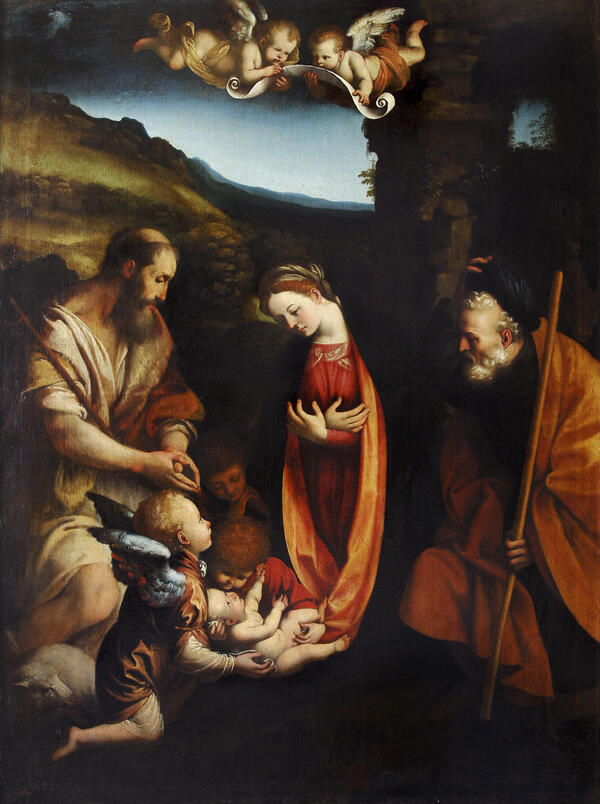“The Holy Family” was painted by an unknown Italian artist. Presumably, this is a loose copy of a painting by Gaudenzio Ferrari.
Gaudenzio Ferrari was an Italian painter of the High Renaissance. He was born in 1475 in Piedmont. He studied in Milan and Florence, was a student of Leonardo da Vinci and Raphael Santi, and represented the Lombard school.
There are a lot of iconographic variations of the “Adoration of the Christ Child”. This is due to the fact that the Gospels of Luke and Matthew describe the Nativity scene quite concisely, focusing instead on the worship of the magi and shepherds. The Proto-Gospel of James, as well as the Gospel of Pseudo-Matthew, on the other hand, tell more about the Nativity. Thanks to them, the scene was supplemented with numerous details, and new characters appeared, that became popular participants in the plot: a donkey and an ox. Renaissance artists often combined several plots of different times in one work.
The painting entered the gallery as the work of Gaudenzio Ferrari named “The Holy Family”. In 1971, the painting was under restoration in Moscow. According to the conclusion of the restoration panel, the work was identified as a loose copy of the painting “Adoration of the Child” by Gaudenzio Ferrari, though it was not possible to locate the original at that time.
A few years ago, experts from the State Hermitage Museum, dating the work to the first half of the 16th century, suggested that the work could be painted by Ferrari himself. However, in 2020, the staff of the art gallery found a probable original — the painting “The Worship of the Child with a Donor” by Gaudenzio Ferrari. In 2010, the work was bought at auction and is now in a private collection. In place of the shepherd, it depicts a portrait of a donor — the customer of the painting, who, judging by his attire, belonged to the church rank.
In the work from the gallery’s collection, the artist turned the donor into a shepherd, almost completely preserving his pose and appearance and even the tonsure on his head. Only the robe changed, a staff appeared in his hand, and a lamb lay down at his feet.
Gaudenzio Ferrari was an Italian painter of the High Renaissance. He was born in 1475 in Piedmont. He studied in Milan and Florence, was a student of Leonardo da Vinci and Raphael Santi, and represented the Lombard school.
There are a lot of iconographic variations of the “Adoration of the Christ Child”. This is due to the fact that the Gospels of Luke and Matthew describe the Nativity scene quite concisely, focusing instead on the worship of the magi and shepherds. The Proto-Gospel of James, as well as the Gospel of Pseudo-Matthew, on the other hand, tell more about the Nativity. Thanks to them, the scene was supplemented with numerous details, and new characters appeared, that became popular participants in the plot: a donkey and an ox. Renaissance artists often combined several plots of different times in one work.
The painting entered the gallery as the work of Gaudenzio Ferrari named “The Holy Family”. In 1971, the painting was under restoration in Moscow. According to the conclusion of the restoration panel, the work was identified as a loose copy of the painting “Adoration of the Child” by Gaudenzio Ferrari, though it was not possible to locate the original at that time.
A few years ago, experts from the State Hermitage Museum, dating the work to the first half of the 16th century, suggested that the work could be painted by Ferrari himself. However, in 2020, the staff of the art gallery found a probable original — the painting “The Worship of the Child with a Donor” by Gaudenzio Ferrari. In 2010, the work was bought at auction and is now in a private collection. In place of the shepherd, it depicts a portrait of a donor — the customer of the painting, who, judging by his attire, belonged to the church rank.
In the work from the gallery’s collection, the artist turned the donor into a shepherd, almost completely preserving his pose and appearance and even the tonsure on his head. Only the robe changed, a staff appeared in his hand, and a lamb lay down at his feet.



